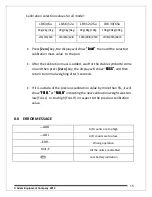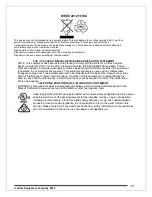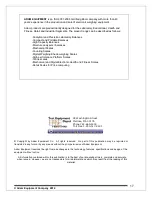
© Adam Equipment Company 2014
14
7.0 CALIBRATION
•
Calibration is recommended for best accuracy. It is suggested that the
scale be calibrated when first installed and any time the scale is moved
to a different environment.
•
To ensure best accuracy calibrate before use.
•
Ensure weights are ready before calibrating, the weight should be of a
known accuracy, for example OIML class M1 or Class 4 of ASTM E617.
•
Do not calibrate the scale if no calibration weight is available.
•
Calibration can only be accessed if the Calibration function has been
enabled as described in section 6.0.
7.1 AUTOMATIC
EXTERNAL
CALIBRATION
•
In the weighing mode, press
[Func]
key
to access calibration mode. The
display will show
“CAL”
.
•
Press
[Zero]
key, an access code (Pin code) is required to continue, The
display will show
“Pin”
.
•
To enter the access code press the
[Func]
key,
[Unit]
key and
[Tare]
key
in sequence,
then press the
[Zero]
key
to confirm the pin code.
•
The display will show the weighing unit last used to calibrate the scale,
“S-Unit kg”
(or
”S-Unit Lb”
) ,press
[Unit]
key to change to lb’s or kg’s for
the calibration weighing unit value.
•
Press
[Zero]
key to start the zero calibration. The display will show
“CAL
0”
and when the stable symbol is displayed press
[Zero]
key
to confirm.
•
The display will now show the calibration mass expected.
”CAL XX Kg “
or
”CAL XX Lb “
.Press
[Tare]
key
to change the calibration values if
necessary. Each model has 3 different kg and lb calibration selection
values.




































